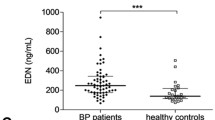Abstract
In order to elucidate the role of eosinophil constituents in urticaria, we investigated major basic protein expression immunohistologically in comparison with that of eosinophilic cationic protein and the low-affinity IgE receptor in lesional and uninvolved skin of different types of urticaria. Eosinophil activation was studied with the markers EG1 and EG2. Different eosinophil constituents were found in all urticarial lesions except those of urticaria pigmentosa. MBP staining tended to be distributed diffusely throughout the tissue, whereas EG1 and EG2 antibodies were located at or close to individual cells. Staining with the low affinity IgE receptor antibody was rare. In uninvolved skin, major basic protein and particularly eosinophilic cationic protein reactivity was found in chronic recurrent urticaria, delayed pressure urticaria and, to a minor degree, in cholinergic urticaria. No correlation was found between antibody reactivity and eosinophil counts. Reactivity with either of the eosinophil constituents is thus a better marker for eosinophil involvement than routine H&E staining of the cells. The demonstration of eosinophil constituents in nonlesional skin of some urticaria patients suggests generalized eosinophil activation in certain subtypes of the disease.
Similar content being viewed by others
References
Butterfield JH, Weiler D, Peterson EA, Gleich GJ, Leiferman C (1990) Sequestration of eosinophil major basic protein in human mast cells. Lab Invest 62: 77–86
Butterworth AE, David JR (1981) Eosinophil function. N Engl J Med 304: 154–156
Czarnetzki BM, Csato M (1989) Comparative studies of human eosinophil migration towards platelet-activating factor and leukotriene B4. Int Arch Allergy Appl Immunoil 88: 191–193
Czarnetzki BM, Rosenbach T (1989) From eosinophil chemotactic factor of anaphylaxis to leukotriene B4 — chemistry, biology and functional significance of eosinophil chemotactic leukotrienes in dermatology. Dermatologica 179: 54 S-59 S
Czarnetzki BM, Meentken J, Kolde G, Bröcker EB (1985) Morphology of the cellular infiltrate in delayed pressure urticaria. J Am Acad Dermatol 12: 253–259
Czarnetzki BM, Zwadlo-Klarwasser G, Bröcker EB, Sorg C (1989) Immunohistochemical demonstration of migration inhibitory factor in different types of urticaria. J Invest Dermatol 93: 471–474
Fujisawa T, Abu-Ghazaleh R, Kita H, Sanderson CJ, Gleich GJ (1990) Regulatory effect of cytokines on eosinophil degranulation. J Immunol 144: 642–646
Gleich GJ (1986) The function of eosinophils. Ann Inst Pasteur Immunol 137D: 136–141
Gleich GJ, Adolphson CR, Leiferman C (1992) Eosinophils. In: Gallin JI, Goldstein IM, Snyderman R (eds) Inflammation. Raven Press, New York, pp 663–700
Grabbe J, Haas N, Hamann K, Kolde G, Hakimi J, Czarnetzki BM (1993) Demonstration of the high affinity IgE receptor on human Langerhans cells in normal and diseased skin. Br J Dermatol 129: 120–123
Greaves MW (1991) Urticaria: new molecular insights and treatments. The Parkes Weber Lecture. J R Coll Physicians Lond 26: 199–203
Hammarlund A, Pipkorn U, EnerbÄck L (1990) Mast cells, tissue histamines and eosinophils in early- and late-phase skin reactions: effects of single dose of prednisolone. Int Arch Allergy Appl Immunol 93: 171–177
Hermes B, Haas N, Grabbe J, Czarnetzki BM (1993) Foreign body granuloma and IgE-pseudolymphoma after multiple bee stings. Br J Dermatol 130: 780–784
Juhlin L, Venge P (1991) Eosinophilic cationic protein (ECP) in skin disorders. Acta Derm Venereol (Stockh) 71: 495–501
Kapp A (1993) The role of eosinophils in the pathogenesis of atopic dermatitis — eosinophil granule proteins as markers of disease activity. Allergy 48: 1–5
Kroegel C, Yukawa T, Dent G, Venge P, Chung KF, Barnes PJ (1989) Stimulation of degranulation from human eosinophils by platelet-activating factor. J Immunol 142: 3518–3526
Lamansku RF, Kaliner M (1988) Late phase IgE-mediated reactions. J Clin Immunol 8: 1–13
Leiferman C (1986) The eosinophil and cutaneous edema. J Am Acad Dermatol 15: 513–517
Leiferman KM, Norris PG, Murphy GM, Hawk JL, Winkelmann RK (1989) Evidence for eosinophil degranulation with deposition of granule major basic protein in solar urticaria. J Am Acad Dermatol 2: 75–80
O'Donnel MC, Ackerman SJ, Gleich GJ, Thomas LL (1983) Activation ob basophil and mast cell histamine release by eosinophil granule major basic protein. J Exp Med 157: 1981–1991
Peters M, Schroeter A, Kephart G, Gleich GJ (1983) Localization of eosinophil granule major basic protein in chronic urticaria. J Invest Dermatol 81: 39–43
Peters MS, Winkelmann RK, Greaves MW, Kephart GM, Gleich GJ (1987) Extracellular deposition of eosinophil granule major basic protein in pressure urticaria. J Am Acad Dermatol 16: 513–517
Richards ML, Katz DH (1991) Biology and chemistry of low affinity IgE receptor (FceRII/CD23). Crit Rev Immunol 11: 65–86
Russel Jones R, Tai PC, Spry JF, Eady RAJ, Kobza Black A, Greaves MW (1985) Criteria for the diagnosis of vasculitis and identification of activated eosinophils. In: Champion RH, Greaves MW, Kobza Black A, Pye RJ (eds) The urticarias. Churchill Livingstone, London, pp 149–155
Schadendorf D, Tiedemann KH, Haas N, Czarnetzki BM (1991) Detection of human papillomaviruses in paraffin-embedded condylomata acuminata — Comparison of Immunohistochemistry, in situ hybridization, and polymerase chain reaction. J Invest Dermatol 97: 549–554
Spry CJ, Tai PC, Barkans J (1985) Tissue localization of human eosinophil cationic protein in allergic diseases. Int Arch Allergy Appl Immunol 77: 252–254
Tai PC, Spry JF, Peterson C, Venge P, Olsson J (1984) Monoclonal antibodies distinguish between storage and secreted forms of eosinophilic cationic protein. Nature 309: 182–184
Wassom DL, Loegering DA, Solley GO, Moore SB, Schoolwy RT, Fauci AS, Gleich GJ (1981) Elevated serum levels of the eosinophil granule major basic protein in patients with eosinophilia. J Clin Invest 67: 651–661
Zweimann B, Atkins PC, von Allmen C, Gleich GJ (1991) Release of eosinophil granule proteins during IgE-mediated allergic skin reactions. J Allergy Clin Immunol 87: 984–992
Author information
Authors and Affiliations
Rights and permissions
About this article
Cite this article
Haas, N., Motel, K. & Czarnetzki, B.M. Comparative immunoreactivity of the eosinophil constituents MBP and ECP in different types of urticaria. Arch Dermatol Res 287, 180–185 (1995). https://doi.org/10.1007/BF01262329
Received:
Issue Date:
DOI: https://doi.org/10.1007/BF01262329




